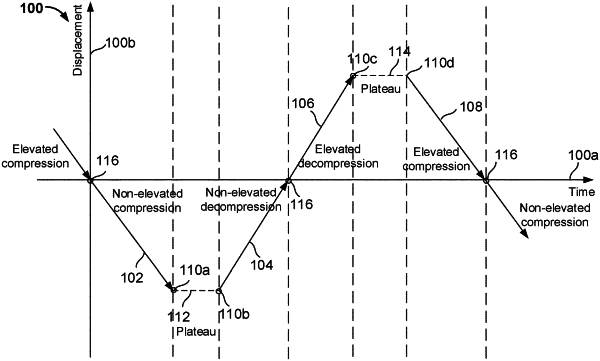| CPC A61H 31/005 (2013.01) [A61H 31/02 (2013.01); G16H 20/30 (2018.01); G16H 20/40 (2018.01); A61H 2031/001 (2013.01); A61H 2031/002 (2013.01); A61H 2201/5061 (2013.01); A61H 2201/5064 (2013.01)] | 41 Claims |

|
1. A method for managing an active compression decompression (ACD) cardiopulmonary resuscitation (CPR) treatment to a patient in need of emergency assistance, the method comprising:
receiving, from at least one sensor coupled to the patient's chest, data comprising a displacement of at least a portion of the patient's chest and a force applied by an applicator device during the ACD CPR treatment, wherein the ACD CPR treatment comprises phases, the phases comprising at least an elevated compression phase, a non-elevated compression phase, an elevated decompression phase, and a non-elevated decompression phase;
processing the data comprising the displacement and the force during the ACD CPR treatment;
identifying a neutral point associated with a zero force being exerted on the patient's chest during a cycle of the ACD CPR treatment, the cycle comprising a continuous variation from a non-elevated compressed chest position during the non-elevated compression phase to an elevated decompressed chest position during the elevated decompression phase, wherein the neutral point changes over a course of the ACD CPR treatment;
determining, based on the neutral point, whether a transition point between a current phase and a next phase in the ACD CPR treatment has been reached; and
in response to determining that the transition point between the current phase and the next phase has been reached, automatically adjusting one or more application parameters for the applicator device to correspond to a subsequent phase of the ACD CPR treatment.
|
|
19. A system for managing an active compression decompression (ACD) cardiopulmonary resuscitation (CPR) treatment to a patient in need of emergency assistance, the system comprising:
an applicator device configured to provide the ACD CPR treatment to the patient's chest according to phases, the phases comprising at least an elevated compression phase, a non-elevated compression phase, an elevated decompression phase, and a non-elevated decompression phase;
at least one sensor configured to be coupled to the patient's chest and to measure a displacement of at least a portion of the patient's chest and a force applied by the applicator device during the ACD CPR treatment; and
one or more processors and a non-transitory computer readable storage medium encoded with a computer program comprising instructions that, when executed, cause the one or more processors to perform operations comprising:
processing the displacement and the force during the ACD CPR treatment,
identifying a neutral point associated with a zero force being exerted on the patient's chest during a cycle of the ACD CPR treatment, the cycle comprising a continuous variation from a non-elevated compressed chest position during the non-elevated compression phase to an elevated decompressed chest position during the elevated decompression phase, wherein the neutral point changes over a course of the ACD CPR treatment,
determining, based on the neutral point, whether at least one transition point between a current phase and a next phase in the ACD CPR treatment has been reached, and
in response to determining that the transition point between the current phase and the next phase in the ACD CPR treatment has been reached, adjusting one or more application parameters for the applicator device to correspond to a subsequent phase of the ACD CPR treatment.
|